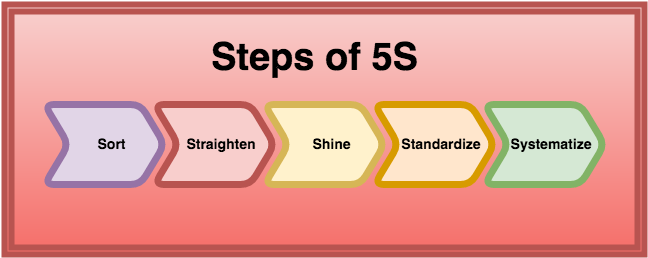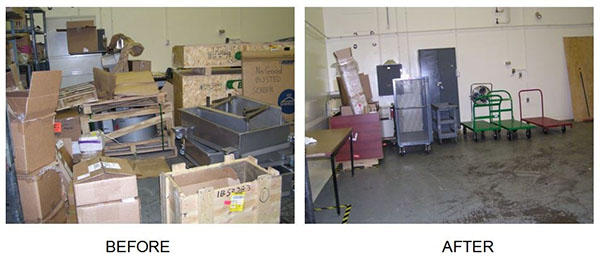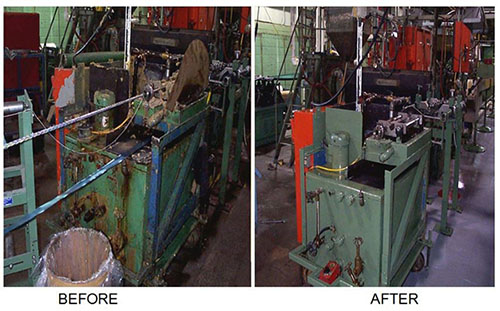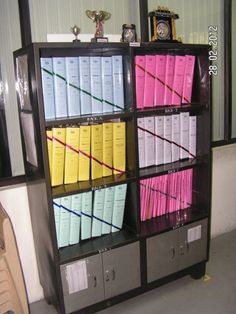5S

What is 5S?
5S is a system for organizing spaces so work can be performed efficiently, effectively, and safely. This system focuses on putting everything where it belongs and keeping the workplace clean, which makes it easier for people to do their jobs without wasting time or risking injury.
5S is the foundation of all improvements and is the key component of establishing a Visual Workplace. Both are a part of Kaizen — a system of continual improvement which is a component of lean manufacturing.
A 5 S program focuses on having visual order, organization, cleanliness and standardization. The results you can expect from a Five S program are: improved profitability, efficiency, service and safety.
The principles underlying a 5S program at first appear to be simple and obvious common sense. However, when implemented in a disciplined manner the above benefits will accrue.
5S represents 5 disciplines to maintain visual at workplace. It is a fundamental activity to improve business. 5S represents systematic approach for productivity, quality and safety improvement in all types of business. It is one of the important approaches in journey of continuous improvement is 5S.
5S program focuses on having visual order, organization, cleanliness and standardization.
5S simplifies and organizes your work environment, reduces waste and non-value activity while improving quality efficiency and safety. And a well organized workplace motivates people.
The program is called 5S, since all steps start with an "S".
5S uses five Japanese disciplines

- Seiri(Sort)
- Seiton(Set)
- Seiso(Shine)
- Seiketsu (Standardization)
- Shitsuke (Sustain)
- Remove items not used in area – out-dated materials, broken equipment, redundant equipment, files on the computer, measurements which you no longer use
- Ask staff to tag all items which they don’t think are needed – this improves understanding about need and use
- Classify all equipment and materials by frequency of use to help decide if it should be removed – place ‘Red Tag’ on items to be removed
- Establish a ‘holding area’ for items that are difficult to classify – hold item for allotted period to enable others not on 5S team to review
 Seiton: It means Orderliness. It means setting everything in proper order for easy retrieval.
Straighten (seiton) – The practice of orderly storage so the right item can be picked efficiently (without waste) at the right time, easy to access for everyone. Place for everything and everything in its own place.
Seiton: It means Orderliness. It means setting everything in proper order for easy retrieval.
Straighten (seiton) – The practice of orderly storage so the right item can be picked efficiently (without waste) at the right time, easy to access for everyone. Place for everything and everything in its own place.
- Identify and allocate a place for all the materials needed for your work
- Assign fixed places and fixed quantity
- Make it compact
- Place heavy objects at a height where they are easy to pick from
- Decide how things should be put away, and obey those rules
 Seiso: It means cleanliness. Everyone should clean the workplace on regular basis.
Shine (seiso) – Create a clean worksite without garbage, dirt and dust, so problems can be more easily identified (leaks, spills, excess, damage, etc)
Seiso: It means cleanliness. Everyone should clean the workplace on regular basis.
Shine (seiso) – Create a clean worksite without garbage, dirt and dust, so problems can be more easily identified (leaks, spills, excess, damage, etc)
- Identify root causes of dirtiness, and correct process
- Only one work activity on a workspace at any given time
- Keep tools and equipment clean and in top condition, ready for use at any time
- Cleanliness should be a daily activity – at least 5 minutes per day
- Use chart with signatures/initials shows that the action or review has taken place
- Ensure proper lighting – it can be hard to see dirt and dust
 Seiketsu: It means standardization. Standardize the way of maintaining the cleanliness.
Standardize (seiketsu) – Setting up standards for a neat, clean, workplace
Seiketsu: It means standardization. Standardize the way of maintaining the cleanliness.
Standardize (seiketsu) – Setting up standards for a neat, clean, workplace
- Standardization of best practices through 'visual management'
- Make abnormalities visible to management
- Keep each area consistent with one another
- Standards make it easy to move workers into different areas
- Create process of how to maintain the standard with defined roles and responsibilities
- Make it easy for everyone to identify the state of normal or abnormal conditions – place photos on the walls, to provide visual reminder
 Shitsuke: It means maintain. Maintain the above all four. It means commitment.
Sustain (shitsuke) – Implementing behaviors and habits to maintain the established standards over the long term, and making the workplace organization the key to managing the process for success
Shitsuke: It means maintain. Maintain the above all four. It means commitment.
Sustain (shitsuke) – Implementing behaviors and habits to maintain the established standards over the long term, and making the workplace organization the key to managing the process for success
- Toughest phase is to Sustain – many fall short of this goal
- Establish and maintain responsibilities – requires leader commitment to follow through
- Every one sticks to the rules and makes it a habit
- Participation of everyone in developing good habits and buy-in
- Regular audits and reviews
- Get to root cause of issues
- Aim for higher 5S levels – continuous improvement
The Origins of 5S – 5S & Lean Manufacturing
5S began as part of the Toyota Production System (TPS), the manufacturing method begun by leaders at the Toyota Motor Company in the early and mid-20th century. This system, often referred to as Lean manufacturing in the West, aims to increase the value of products or services for customers. This is often accomplished by finding and eliminating waste from production processes.

Lean manufacturing involves the use of many tools such as 5S, kaizen, kanban, jidoka, heijunka, and poka-yoke. 5S is considered a foundational part of the Toyota Production System because until the workplace is in a clean, organized state, achieving consistently good results is difficult. A messy, cluttered space can lead to mistakes, slowdowns in production, and even accidents, all of which interrupt operations and negatively impact a company. By having a systematically organized facility, a company increases the likelihood that production will occur exactly as it should.
Do you recognize any of these 7 Wastes in your workplace?
Defects: These are products or services that deviate from customer specifications. Most people only think of the scrap cost associated with a defect. The costs of problem solving, materials, labor hours, paperwork and decreased customer retention are much higher than the scrapped item.
Inventory: This is the amount of raw materials, work in progress or finished goods that a company is holding. Each piece of inventory being carries a cost and is likely gathering interest. There are additional costs from overproduction, storage, transportation costs, damage, loss and paperwork.
Motion: Just because an employee is moving doesn’t mean they’re working. Think of all the wasteful steps in a current process in your facility. Are employees forced to take unnecessary steps to perform their job function? Employees that exert more energy on non-value added processes like lifting, retrieving or searching produce less. They’re also at higher risk of injuries.
Non-Value Added Processes: Are employees spending time and energy doing work that isn’t part of their job? For example, are they sanding or polishing areas that aren’t visible in its final form? Not only does that cost time and labour, but there’s also increased material and equipment usage. The more a company uses equipment, the more costs are associated with maintenance, service, repair and replacement.
Overproduction: This is often considered the worst of the seven wastes. Producing products or services too fast or too often has its own set of problems. Overproduction leads to unreliable processes, unbalanced work cells and inaccurate predictions of future orders. Overproduction is also responsible for holding up capital in raw materials, stocked items and finished goods. As a rule of thumb, companies should avoid overproduction by balancing supply to demand.
Transportation: The cost of transportation in manufacturing is always a loss to the bottom line. There’s a reason why many suppliers are within close proximity to their plants. By limiting transportation distances, companies can minimize the costs of overproduction, transport, storage, damage, loss and material handling fees.
Waiting: How often do you notice employees standing around? Are they waiting for a previous step in the process to be completed? Are they waiting for parts, supplies or products to arrive? Are they waiting for clear instructions on their next step? The cost of waiting is huge and you can never recover those costs. There are ways to reduce waiting costs. For example, you can implement standard operating procedures (SOP). SOPs ensure clear communication, improve time management and minimize transport between work cells.
Who can benefit from using the 5S system?
5S can be used in any workplace and in any industry. It’s effective in industries such as manufacturing, healthcare, government and service industries. But, production and logistic managers can use the 5S system in a wide array of industries.
Manufacturing:- Automobile manufacturing
- Aerospace
- Foundries
- Parts manufacturing Service Industries:
- Construction
- Plumbing
- Auto mechanic
- Body shops Government:
- Public service
- Transportation Healthcare:
- Medical device manufacturing
- Hospitals
5S can improve worker safety, productivity, quality and efficiency in any workplace.
Get in Touch! Ask us any question/query on +91-9867-180-395. We would be happy to answer your concerns. You can also drop an email at info@ascentinspecta.com
